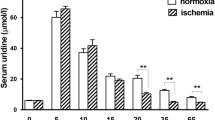Abstract
ATP synthesis inhibited by Cyclosporine A is restored by calcium channel blockers: nifedipine, verapamil, bepridil, diltiazem. ATP synthesis was estimated using liver mitochondria by measuring the rate of respiration during state 3 and a measure of the yield of ATP synthesis, the P/O ratio. The study of calcium fluxes through mitochondrial membrane indicates that calcium channel blockers counteract the mitochondrial calcium storage induced by Cyclosporine A. If the restoration of ATP synthesis observed in vitro also occurred in vivo, the increase in ATP pool might contribute to a better functioning of the Ca2+ extrusion pumps of the cells, thereby maintaining the cytosolic calcium concentration (Cai) in the normal range. The nephrotoxicity of Cyclosporine A appears to be due to a vasoconstrictive effect related to an increased Cai This result may account for the reduction of clinical Cyclosporine A toxicity by calcium channel blockers. Verapamil appears to be the most efficient in restoring ATP synthesis.
Similar content being viewed by others
REFERENCES
R. G. Luke. Mechanism of Cyclosporine induced hypertension. Am J Hypert 4, 468–471 (1991).
J. S. Abraham, F. R. Bentley, R. N. Garrison, H. M. Cryer. Cyclosporine A directly constricts intrarenal arterioles. Transplant Proc 23, 356–359 (1991).
N. Fournier, G. Ducet, and A. Crevat. Action of Cyclosporine A on mitochondrial calcium fluxes. J. Bioenenerg Biomembrane 19, 297–303 (1987).
C. Richter, M. Theus, J. Schlegel. Cyclosporine A inhibits mitochondrial pyridine nucleotide hydrolysis and calcium release. Biochem Pharmacol 4, 779–782 (1990).
KM. Broekemeier, ME. Dempsey, DR. Pfeiffer. Cyclosporine A is a potent inhibitor of the inner membrane permeability transition in liver mitochondria. J Biol Chem 264, 7826–7830 (1989).
P. Bernardini, P. Veronese, V. Petronilli. Modulation of the mitochondrial cyclosporine A sensitive permeability transition pore. J Biol Chem 268, 1005–1010 (1993).
M. Tuena De Gomes-Puyou, MN. Gavilanes, A. Gomes-Puyou, C. Ernster. Control of activity states of heart mitochondrial ATPase. Role of the proton-motive force and Ca2+. Biochim Biophys Acta 592, 336–405 (1980).
M. D. Salducci, A. M. Chauvet-Monges, Y. Berland, B. Dussol, R. Elsen, A. Crevat. The restoration of ATP synthesis may explain the protective effect of calcium channel blocker against Cyclosporine A nephrotoxicity. Life Sci 50, 2053–2058 (1992).
H. Meyer-Lehnert, U. Friedrichs, D. Bokemeyer, S. Drechsler, H. J. Kramer. Cyclosporin A-induced calcium accumulation in glomerular mesangial cells. Inhibition by atrial natriuretic peptide (ANP) (abstract). J Amer Soc Nephrol 4, 756, (1993).
I. Dawidson, P. Rooth, W. R. Fry et al. Prevention of acute cyclosporine-induced renal blood flow inhibition and improved immunosuppression with verapamil. Transplantation 48, 575–580 (1989).
J. E. Scoble, J. C. M. Senior, P. Chan, Z. Varghese, P. Swery, J. F. Moorhead. In vitro Cyclosporine toxicity. Transplantation 47, 647–650 (1989).
G. Johnson, H. Lardy. Isolation of liver or kidney mitochondria. In P. W. Estabrook and M. Pullman, Methods in Enzymology, Academic Press New York, 1967, p. 94–96.
G. Ubeaud, A. M. Chauvet-Monges, J. P. Monti, J. P. Tillement, and A. Crevat. Calcium antiionophoretic effect of some calcium channel blockers in rat liver mitochondria. J Pharm Sci 83, 165–168 (1994).
M. Spedding. Calcium antagonist subgroups. Trends Pharmacol Sci 3, 109–114 (1985).
J. Brockmöller, H. H. Neumayer, K. Wagner, W. Weber, G. Heinemeyer, H. Kewitz, and I. Roots. Pharmacokinetic interaction between cyclosporin and diltiazem. Eur J Clin Pharmacol 38, 237–242 (1990).
G. E. N. Kass, M. J. Juedes, S. Orrenius. Cyclosporine A protects hepatocytes against prooxidant-induced cell killing. Biochem Pharmacol 44, 1995–2003 (1992).
C. Richter, J. Schlegel. Mitochondrial calcium release induced by prooxidants. Toxicol Lett 67, 119–127 (1993).
R. B. Khauli, T. Strzelecki, S. Kumar, M. Fink, J. Stoff, M. Menon. Mitochondrial alterations after Cyclosporine and ischemia, Insights on the pathophysiology of nephrotoxity. Transplant Proc 19, 1395–1397 (1987).
D. C. Pang, N. Sperelakin. Nifedipine, Diltiazem, Bepridil and Verapamil uptake into cardiac and smooth muscles. Eur J Pharmacol 87, 199–207 (1983).
G. Zernig, I. Graziadei, T. Moshammer, C. Zech, N. Reider, H. Glossmann. Mitochondrial Ca2+ antagonists binding sites are associated with an inner mitochondrial membrane anion channel. Mol Pharmacol 38, 362–369 (1990).
Rights and permissions
About this article
Cite this article
Salducci, M.D., Chauvet-Monges, A.M., Dussol, B.M. et al. Is the Beneficial Effect of Calcium Channel Blockers Against Cyclosporine A Toxicity Related to a Restoration of ATP Synthesis?. Pharm Res 12, 518–522 (1995). https://doi.org/10.1023/A:1016293627487
Issue Date:
DOI: https://doi.org/10.1023/A:1016293627487




